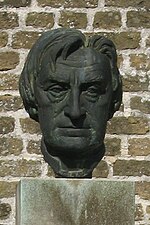Cyriel Verschaeve
Cyriel Verschaeve | |
|---|---|
 Statue of Verschaeve in Alveringem | |
| Born | 30 April 1874 |
| Died | 8 November 1949 (aged 75) |
| Occupation(s) | Priest, writer, SS recruitment |
Cyriel Verschaeve (30 April 1874 – 8 November 1949) was a
Early years
Born in
Nationalist leader

He returned to Belgium in 1911 to become a parish priest at
Second World War
Dismissed as chaplain in 1939,
Death
He fled to Austria in 1945. He was condemned to death in absentia by a Belgian court, but survived in Austria until 1949, when he died of a heart attack at the
Streets in Kortrijk, Lanaken and Breendonk were named after him; in 2019-2020 the local councils decided to rename it.[12]
Writing
Verschaeve wrote extensively on philosophy, adopting a dramatic, poetic writing style. He was also known as a poet and playwright. As an author he wrote a number of plays dealing with historical and Biblical characters with Judas (1919) and Maria-Magdalena (1930) now widely held to be the best works from a prolific but sketchy output.[13] His major works include:
- Jacob van Artevelde (1911)
- Zeesymphonieën (1911)
- Ferdinand Verbiest (1912)
- De schoonheid van het evangelie (1913)
- Passieverhaal (1913)
- Philips van Artevelde (1913)
- Nocturnen (1916–1924)
- Judas (1917)
- Het mysterie (1920)
- Uren bewondering voor groote kunstwerken (1920–1922)
- Maria Magdalena (1928)
- De Kruisboom (1929)
- Elijah (1936)
- Nocturnen (1936)
- Rubens, Vlaanderens Spectrum (1938)
- Jezus (1939)
- Eeuwige gestalten (1944)
References
- ^ Ingo Haar, Michael Fahlbusch, German Scholars and Ethnic Cleansing, 1919–1945, Berghahn Books, 2006, p. 195
- ^ Karen Dale Shelby, Conflicted Nationalism and World War I in Belgium: Memory and Museum Design, ProQuest, 2008, pp. 37–38
- ^ Shelby, Conflicted Nationalism and World War I in Belgium, p. 54
- ^ Herman Van Goethem, Belgium and the Monarchy: From National Independence to National Disintegration, Asp/Vubpress/Upa, 2011, pp. 115–116
- ^ Shelby, Conflicted Nationalism and World War I in Belgium, p. 58
- ^ Shelby, Conflicted Nationalism and World War I in Belgium, p. 75
- ^ a b Shelby, Conflicted Nationalism and World War I in Belgium, p. 103
- ^ a b c d e Shelby, Conflicted Nationalism and World War I in Belgium, p. 104
- ^ Els Witte, Jan Craeybeckx, Alain Meynen, Political History of Belgium: From 1830 Onwards, Asp/Vubpress/Upa, 2010, p. 206
- ^ a b Shelby, Conflicted Nationalism and World War I in Belgium, p. 105
- ^ Shelby, Conflicted Nationalism and World War I in Belgium, p. 106
- ^ Daniel Boffey (24 November 2019). "Belgium begins to face brutal colonial legacy of Leopold II". The Observer.
- ^ John Gassner, The Reader's Encyclopedia of World Drama, Courier Dover Publications,, 2002, p. 62
